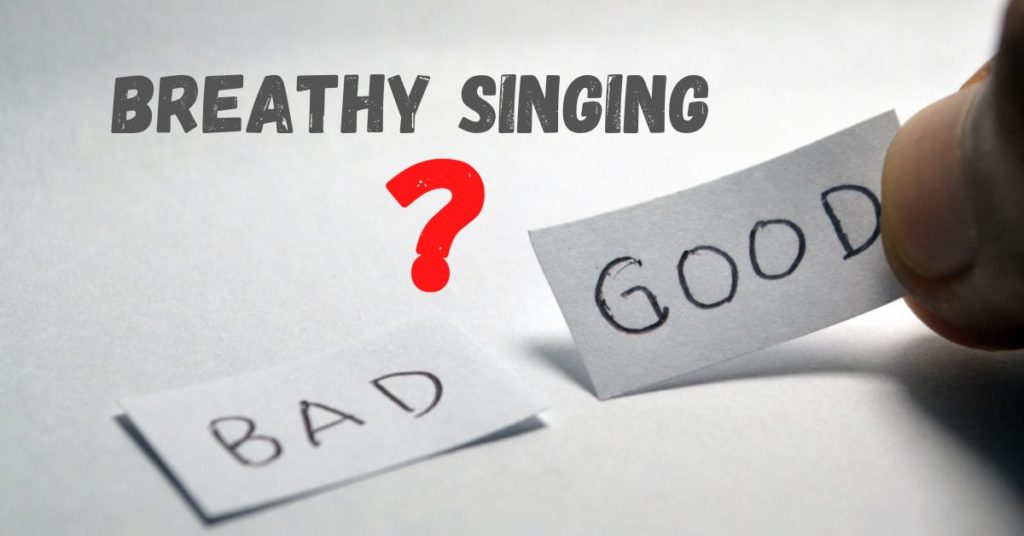
Breathy singing can be a useful vocal color, but it can also be a problem when overused or not in the singer’s control.
Even worse is when the singer is unable to get out of a constantly breathy condition.
If you find excessive breathiness to be a persistent vocal issue, here are my thoughts and some practical singing techniques you can use to combat it.
When Breathy Singing Is Bad
Here is where an airy voice becomes a problem - if breathiness is chronic and consistent and you really can’t seem to shake it.
First and foremost, you want to rule out any vocal cord disorders. If your breathiness is chronic and you can't get proper vocal cord closure on any vocal exercises , you might consider seeing an ear, nose, and throat doctor.
Your doctor can check that you’re not dealing with vocal nodules or polyps, also, you’re not dealing with reflux that can keep your vocal cords inflamed.
There’s a number of issues that can cause breathiness. Your vocal cords can get a little bowed so that they don’t come together in a straight line. The vocal folds bow apart much like bowed legs, and the air will pass between them because you’re not going to get that tight seal and compression over the air.
Singers can also have different levels of vocal fold paralysis or paresis where the vocal cords (or "folds") don’t totally come to center, or maybe one vocal fold will come to center, and the other doesn’t, creating a small gap.
Many of these issues can be improved through vocal training. Still, if you’re experiencing constant breathy phonation, it’s best to seek out a professional to know exactly what you are dealing with.
Breathy Tone As An Artistic Choice

A breathy tone is a legitimate artistic choice. Many singers make breathy voice technique part of their sound.
An example of professional singers who use this technique very successfully as texture and flavor are Mariah Carey, Ariana Grande, and Sam Smith, to name a few. However, if breathiness is something you incorporate it as part of your style and use a lot, you want to be careful.
First of all, using breathiness in the studio versus live is completely different. In the studio, you’re singing into very expensive condenser microphones that are highly sensitive.
Your little breathy textures and light vocal tones will get picked up by the microphone, and then when it’s mixed, everything can be balanced and EQ’ed and level set so that the breathiness has texture and can really be heard. It's a nice effect when used properly.
When singing live, however, a lot of that flies out the window.
You are not going to use those expensive mics because they are too sensitive, and you have a lot of stage noise.
Condenser mics are also more fragile, so you tend to use tougher mics like the good old Shure SM58, which you could basically use to hammer nails into a board and then continue singing with it.
In live situations, subtle textures are harder to hear.. A breathy voice goes through a less sensitive microphone and mixes with instruments, the noise of a crowd and the sonic flaws of most places that you will perform.
Basically, your breathiness is going to get lost.
If you check out performances of singers, they usually aren't as breathy live. You need to adjust your singing to each situation.
Sometimes a breathy style is coming from not so much an artistic choice, but the fact that the singer is dealing with some vocal problems themselves, perhaps vocal fatigue, vocal weakness, problems with their technique.
They’re not able to sing into certain areas of their voice as strongly as they might like. So they use breathiness as an artistic cover-up if you will.
And I find when I work with singers who are excellent musicians and artists, they have clever ways of hiding their vocal imperfections.
Singers get very creative at making everything sound like they are doing it on purpose, so my job is to find and fix all of the little bugs in their voice.
When singers use certain things like an airy singing voice, flipping, or yelling, that sometimes it’s an artistic choice, but it is often issues with their voice and technique.
I believe everything, for art’s sake, is permitted and correct. Any sound that you want to make, if that’s what you want to express, you go for it.
However, I recommend that those sounds be within your control. If the only way to make a sound is to yell or be breathy, you may have vocal issues down the line.
How Tough Is Your Voice?

Some of us are more sensitive vocally than others. There is a genetic component to the amount of stress your voice can withstand. And there is a percentage of the population that can stress their cords pretty hard and not experience the swelling that the average population does.
And then there’s a percentage of the population where the cords are a little hypersensitive, and they will begin to swell before the average person’s cords.
So it’s a good idea to know where you are on the spectrum. Just because your favorite singer can seem to down a few shots of Jack Daniels and then go out there and scream out a song doesn’t necessarily mean you can do the same thing and experience the same result. You may end up with vocal swelling you don’t want.
However, breathy singing, while not as stressful as yelling, can cause issues with your vocal folds.
Don't Let Your Voice "Fry" and "Dry"

You can irritate the cords by doing lots and lots of breathy singing or talking because excess air is passing over the folds.
Your vocal folds or cords need to have nice thin mucus on them and excess air is like somebody blowing into your eyeball. It would get very irritating, and it would dry out your eye. And this excess air over the vocal folds can be irritating.
And that’s what we want to eliminate. If you are experiencing breathiness, your cords are not properly closing over and compressing the air you are sending to them.
We call this compressed air "subglottal pressure." If the cords don’t close properly, you’re not going to get enough subglottal pressure to create a proper soundwave.
The other thing is you will run out of air very, very quickly even though you’re not making that much sound. Sometimes people think that a big loud vocal sound takes lots of air, and quite frankly, singing with a breathy voice takes far more air because a lot of it is not being utilized.
The breath is being wasted acoustically. It just passes through the vocal folds without being compressed into a sound wave.
And so we get that breathy sound, and you’re going to run out of air. The cords can feel a little dry, and they can get a little tired. You’re certainly going to lose some control, and also, it can sneak its way into the speaking voice.
And a lot of times, singers who have issues with their singing voice will often have issues with their speaking voice.
A breathy, that consistently dips into a crackly vocal "fry" will put excess wear on the voice, making you feel vocally tired even though you haven't been singing.
I recommend that singers not allow themselves to be down in fry all the time or to speak with a breathy voice because it’s not keeping the cords operating at an optimal level of phonation.
You really don’t have the luxury of being lazy with your voice as a singer. Your job is to create sounds with those two little pieces of soft tissue, and if you’re good enough and a little bit lucky, lots of people will pay you to hear those two little pieces of soft tissue vibrate. So you want to be very particular and careful with how you use them.
Vocal Exercises
We are going to start down in your lower register or what we will call the "chest voice," so named because if you put your hand on your chest plate and say, “Uh,” you’ll feel more sympathetic vibrations than you do on the higher notes.
It’s just how the voice vibrates, how it couples with the resonating spaces, and how the sound waves bounce around. We will pick up sympathetic vibrations in the chest; hence it’s called "chest voice."
Start down in the lower chest register and what we want to do is we want to work exercises to bring the vocal cords together. If you’re experiencing breathiness, it’s very much like a trumpet player. Rather than having a proper embouchure, they let their lips be a little too relaxed, and you get that breathy sound.
Again, if you continue to experience breathiness and the exercises do not help, my disclaimer going forward, is yeah, you should probably see an ENT and make sure that everything is all clear.
1) Creaky Swinging Gate
Now, what we want to do is we want to encourage those vocal cords to come to center and meet just like the trumpet player’s lips. And an excellent way to do that is to make a little noise like a creaky gate swinging open.
Use this edgy little sound on your favorite vocal scale patterns. I demonstrate and recommend some scales in the video below.
2) "Nay" Sound
The next step is to use a bright, bratty sounding "NAY". Now, this isn’t an optimal singing sound, but it's great for bringing the vocal cords together.
Keep the intensity on this exercise, and focus on not letting the sound go light or breathy.
I demonstrate in the video below.
3) "Ma" Sound
Now use the word "MA" with a little less of the "bratty" exaggeration. The goal is to keep the intensity and cord closure of the previous exercise while moving towards a more natural or finished vocal sound.
4) "Go" Sound And Emotion
Harnessing natural emotion is a great way to find vocal coordinations.
I like to do is have the student pretend they are a little angry and say, “GO, GO, GO”
Now watch that you don’t start squeeze. But if you get a little bit of emotion in there, that will tend to make the voice come together. Very few people are breathy when they’re angry or when they’re excited, unless, of course, there is a medical issue with the vocal folds, like a nodule that’s going to stop them from coming together. But most people, when they get kind of a little hyped up, emotionally moving if you will, the vocal folds are going to come together better.
And emotion is part of singing. So don’t be afraid to get yourself a little emotionally hyped up in the practice room when you’re working on your voice and get a little angry.
GO, GO GO - feel those cords coming together. And it shouldn’t take much. Do it in your lower register first. Eventually, you can start to take it into your upper notes, that transition or that mix area up into your upper register or head voice.
Watch this video to learn how to do the above exercises:
Putting It All Together
The main thing is to be aware of your breathiness and when you catch yourself singing breathy, stop. I would not sing breathy for a little while until it’s under your control.
Once you have better control, you can stylistically bring breathiness back in.

Usually, when I work a student on a song, the first few times through, I’ll have them really sing the song simply while we get everything balanced, everything in this nice centered place before they start to add style.
Once the song is feeling solid we can add some breathiness, put in a flip here, let the voice fall off there, sustain without vibrato, all of the things where we start to play with this idea of perfect vocal technique.
In contemporary music, perfect vocal technique is not necessarily what people want to hear. We have to get a little dicey with it and play around, but it’s really a good idea to have the technique down first, sing everything spot on, and then start to mess with it.
Take your time and be consistent, and you should feel your voice start to build up fairly quickly.
Good singing technique will give you control of all the sounds your voice can make (including a breathy quality) and help you become a true musical artist.